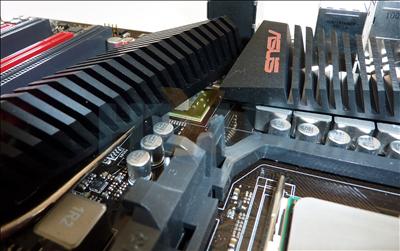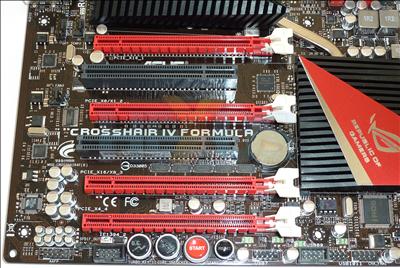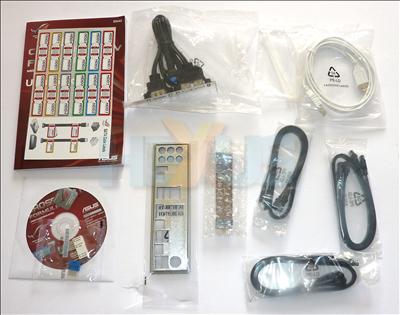Crosshair IV Formula under the microscope
The 890FX underpinnings mean that ASUS already has a good start with the Crosshair IV Formula, but the RoG brand is all about adding the proverbial kitchen sink to an already-impressive specification.
A high-level look shows us that the board has four PCIe x16 mechanical slots and two PCIc. Rival manufacturers offer up-to six PCIe x16, but that's just unnecessary overkill in our opinion.
The board's AM3 socket - powered by an 8+2-phase power design - supports AMD CPUs with a TDP of up to 140W, whilst dual-channel memory slots support up to 16GB of DDR3 at speeds of up to 1,866MHz - 2GHz+ with certain profiles. ASUS clearly intends this board to be paired with a six-core chip.
A SupremeFX X-Fi audio chip is integrated as standard, as are a bevy of ASUS-exclusive tweaking tools - including RoG Connect, GameFirst, Extreme Tweaker and Core Unlocker, which allows users to potentially enable hidden/disabled cores on certain AMD CPUs at the touch of a button.
On top of that you'll find eight fan connectors, seven ProbeIt measurement points and three thermal sensor connectors. Everything a tweaking man needs.
The RoG Connect feature is worthy of particular mention. An I/O-mounted, RoG-specific USB port enables you to hook the board up to another system/notebook that runs Windows and then overclock/tweak the Crosshair IV Formula remotely, which is very cool.
A contender for one of the best-looking AMD boards to date? Perhaps, and ASUS has hit the nail on the head with the AMD Radeon-inspired red-and-black colour scheme set against angular heatsinks.
Six of the seven SATA ports are of the 6Gbps variety, powered by AMD's SB850 southbridge and supporting RAID modes 0, 1, 5 and 10, whilst the standalone seventh SATA port provides 3Gbps connectivity courtesy of a JMicron JMB363 controller. The only concern we have is that accessing side-mounted SATA ports can be a little fiddly in small chassis. Users with older IDE-based drives are left high and dry; there's no IDE port on the Formula, even though it's specified by AMD.
The southbridge heatsink looks cool, but it's also suitably low profile so as not to hamper the use of any PCIe slot.
Speaking of expansion slots, the Crosshair IV Formula has a useful selection. The topmost three PCIe x16 electrical slots are designed primarily with graphics cards in mind, allowing for a single card at x16, dual cards at x16, x16 or a three-way CrossFire configuration at x16, x8, x8. It's an all-AMD affair, though, as there's no support for NVIDIA SLI, naturally.
The fourth PCIe 2.0 lane operates at x4 electrically, and two PCIc 2.2 slots complete the line-up. Alongside the board's Start and Reset buttons reside a dedicated Core Unlocker button and a dedicated Turbo Key II switch that overclocks the CPU - 3.7GHz and 232MHz clock for a Phenom II X6 1090T - without the user having to manually tinker with the BIOS.
Keeping the features coming, the rear I/O panel provides a single 3Gbps eSATA connector (powered by the JMicron JMB363 controller), eight USB 2.0 ports (including the RoG-specific port), two USB 3.0 ports (powered by the omnipresent NEC controller), FireWire, a single Gigabit Ethernet and a choice of eight-channel audio or optical S/PDIF out. Overclockers are also treated to a RoG Connect on/off switch and a Clear CMOS switch.
The bundle is decent enough and includes the RoG USB cable and a fly bracket that houses two USB 2.0 ports and an eSATA. We like the right-angled SATA cables, the ever-useful Q-connector pack, and stickers that make it simple to identify cables.















